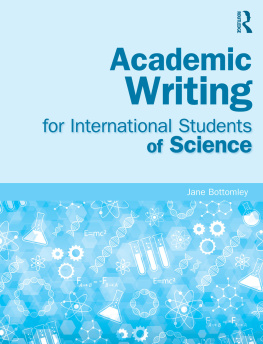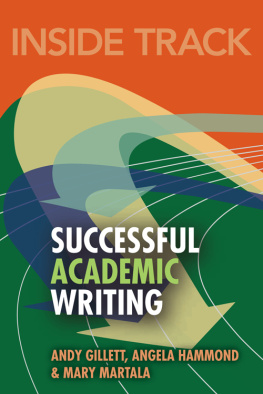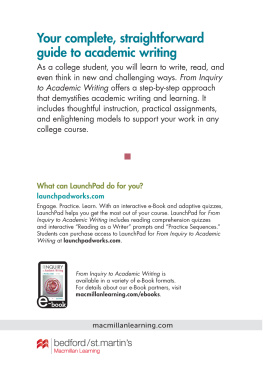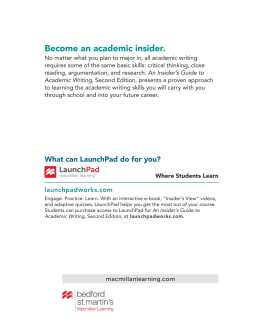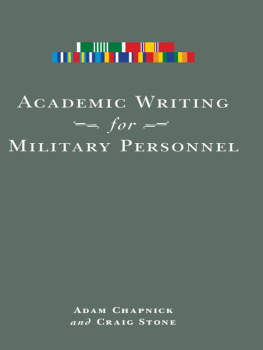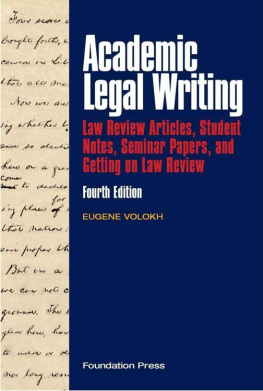
Academic Writing for International Students of Science
Academic Writing for International Students of Science will help international students to develop their command of academic scientific writing in English. It guides students through the writing process itself and will help them to produce clear, well-written and well-organised essays and reports. The book covers a range of issues, such as how to explain complex ideas clearly and concisely, how to develop a coherent argument and how to avoid plagiarism by making effective reference to sources.
Through detailed analysis of authentic scientific texts, the book will enhance students understanding of the nature of academic scientific writing. This will enable them to understand how language and discourse function in a real scientific context. The texts serve as models of good writing and are followed by practice activities which will help students to develop their own writing skills.
Key topics include:
the writing process;
academic scientific style;
sentence structure;
paragraph development;
referring to sources;
coherence, argument and critical thinking;
academic and scientific conventions.
This book will be an invaluable companion to those studying for a science or technology degree in an English-speaking institution. Informative study boxes, model answers and a clear, comprehensive answer key mean that the book can be used for self-study or with guidance in the classroom.
Jane Bottomley is a Senior Language Tutor at the University of Manchester. She has worked as a writer and editor on a number of books, websites and dictionaries.
Academic Writing for International Students of Science
Jane Bottomley

First published 2015
by Routledge
2 Park Square, Milton Park, Abingdon, Oxon OX14 4RN
and by Routledge
711 Third Avenue, New York, NY 10017
Routledge is an imprint of the Taylor & Francis Group, an informa business
2015 Jane Bottomley
The right of Jane Bottomley to be identified as author of this work has been asserted by her in accordance with sections 77 and 78 of the Copyright, Designs and Patents Act 1988.
All rights reserved. No part of this book may be reprinted or reproduced or utilised in any form or by any electronic, mechanical or other means, now known or hereafter invented, including photocopying and recording, or in any information storage or retrieval system, without permission in writing from the publishers.
Trademark notice: Product or corporate names may be trademarks or registered trademarks, and are used only for identification and explanation without intent to infringe.
British Library Cataloguing in Publication Data
A catalogue record for this book is available from the British Library
Library of Congress Cataloging-in-Publication Data
A catalog record for this book has been requested.
ISBN: 978-0-415-83240-3 (hbk)
ISBN: 978-0-415-83241-0 (pbk)
ISBN: 978-1-315-77805-1 (ebk)
Typeset in Galliard
by Cenveo Publisher Services
Contents


My thanks to the many students, friends and colleagues who have contributed in a number of ways to the development of these materials.
Particular thanks are owed to the following: Michael Burton, cousin and chemist, for his invaluable support, sound advice and detailed assessment of the work in progress; John Morley, Ian Pople, Rob Marks and Vanesa Rodriguez Juiz for their careful scrutiny of various chapters, and excellent suggestions for improvements. Thanks are also due to: Ros Cranston, Sue Boswell-Rees, Phil Leeke and Jenny White for their useful feedback; Joy Baugh for kindly allowing me to use her idea for predicting references; June OBrien for her idea for the task on reordering information; Mark Whitely for his patient explanations of chemistry; Frances Nicholson and Pat Campbell for their kind support.
I would also like to thank the students, skilled writers all, who very generously allowed me to use their work in progress in this book: Sarmed A. Salih; Astone Nanja; Parikshit Deshmukh; Jing Yan. I am also grateful to Victoria Konstantinidi for her keen interest, and helpful ideas on the learners perspective.
My thanks also to Natasha Ellis-Knight and Philip Mudd at Routledge for their careful guidance.
This book is designed to help you, as an international student of science, to develop your command of English language and discourse. It will enable you to produce writing of a high standard, thus helping you to complete written assignments successfully.
You will acquire knowledge, skills and strategies to help you produce writing which is accurate, well-expressed, clear and coherent. You will also reflect on the nature of analysis, argument and critical thinking, all of which give depth to academic writing. In addition, you will learn how to refer to sources effectively, and to employ a range of conventions associated with academic scientific writing.
You will look at the writing process itself, study the mechanics of writing, i.e. grammar and punctuation, and explore the characteristics of academic scientific discourse.
Most example sentences and texts are taken from authentic academic scientific sources, providing you with an opportunity to see how language works in a real-life scientific context. Authentic sources are indicated by references or, in the case of individual sentences or very short texts, by this symbol:

The book adopts a broad view of science which includes the natural sciences, medicine, technology and engineering. Texts have been chosen which are accessible to a general reader. However, it is advised that you use dictionaries and websites to help you with any difficult words, as this will allow you to focus on the nature of the writing rather than individual words.
There are also a number of texts written by students I have worked with at the University of Manchester, all of which demonstrate the improvements they were able to make as they studied some of the things in this book in conjunction with their own skills and hard work!
There are a large number of practical activities, including:
explorative tasks, which help you to explore language use and discourse in academic scientific writing, guiding you towards noticing important patterns, and developing a clear understanding of the rules or tendencies which govern these patterns;
practice activities, which allow you to consolidate your understanding of rules and patterns and put them into practice;
review tasks, which provide you with an opportunity to revise the points covered in a chapter by producing a short text.
When an answer is provided in the Answer Key, this symbol is used:

Next page
